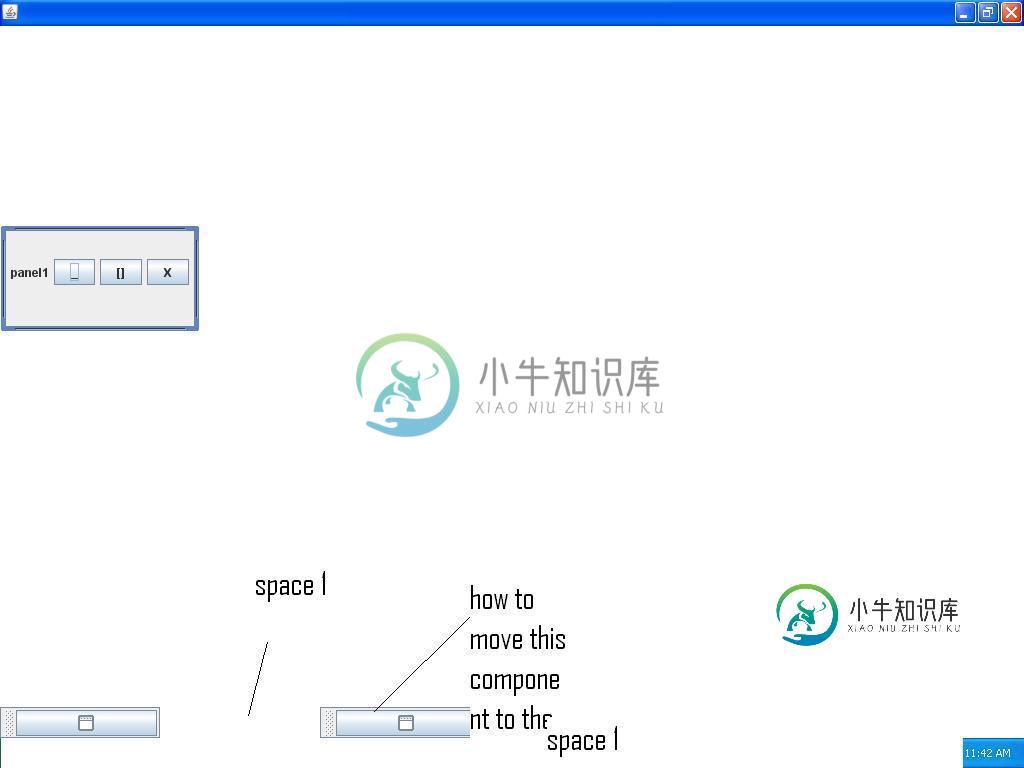如何移动放置在容器底部的最小化组件?
我在一个容器中有三个组件和按钮。当我点击最小化按钮时,组件会最小化到容器的底部,当我点击最小化组件时,它会最大化。
假设三个组件位于底部,如果我最大化第二个组件,那么它就会最大化,而第三个最小化组件不会占据第二个组件的位置,这仍然是空间。

package Project;
import java.awt.Dimension;
import java.awt.GridLayout;
import java.awt.HeadlessException;
import java.awt.event.ActionEvent;
import java.awt.event.ActionListener;
import java.beans.PropertyVetoException;
import javax.swing.JButton;
import javax.swing.JDesktopPane;
import javax.swing.JFrame;
import javax.swing.JInternalFrame;
import javax.swing.JLabel;
import javax.swing.JPanel;
import javax.swing.SwingUtilities;
import javax.swing.plaf.basic.BasicInternalFrameTitlePane;
import javax.swing.plaf.basic.BasicInternalFrameUI;
public class Test2 {
public Test2() throws HeadlessException, PropertyVetoException {
createAndShowGUI();
}
public static void main(String[] args) {
SwingUtilities.invokeLater(new Runnable() {
@Override
public void run() {
try {
new Test2();
} catch (HeadlessException ex) {
ex.printStackTrace();
} catch (PropertyVetoException ex) {
ex.printStackTrace();
}
}
});
}
private void createAndShowGUI() throws HeadlessException, PropertyVetoException {
JFrame frame = new JFrame();
frame.setDefaultCloseOperation(JFrame.DISPOSE_ON_CLOSE);
final JDesktopPane jdp = new JDesktopPane() {
@Override
public Dimension getPreferredSize() {
return new Dimension(600, 400);
}
};
frame.setContentPane(jdp);
frame.pack();
createAndAddInternalFrame(jdp, 0, 0);
createAndAddInternalFrame(jdp, 300, 0);
createAndAddInternalFrame(jdp, 1, 200);
frame.setVisible(true);
}
private void createAndAddInternalFrame(final JDesktopPane jdp, int x, int y) throws PropertyVetoException {
final JInternalFrame jInternalFrame = new JInternalFrame("", true, true, true, true);
jInternalFrame.setLocation(x, y);
JPanel jp = new JPanel();
JLabel jl=new JLabel("panel"+x);
JButton jb = new JButton("_");
JButton jb2 = new JButton("[]");
JButton jb3 = new JButton("X");
jInternalFrame.setLayout(new GridLayout(2, 2));
jp.add(jl);
jp.add(jb);
jp.add(jb2);
jp.add(jb3);
jInternalFrame.add(jp);
jb.addActionListener(new ActionListener() {
@Override
public void actionPerformed(ActionEvent ae) {
try {
if (jInternalFrame.getLayer() == JDesktopPane.FRAME_CONTENT_LAYER) {
jdp.remove(jInternalFrame);
jdp.add(jInternalFrame, JDesktopPane.DEFAULT_LAYER);
jdp.revalidate();
jdp.repaint();
}
jInternalFrame.pack();
jInternalFrame.setIcon(true);
} catch (PropertyVetoException ex) {
ex.printStackTrace();
}
}
});
jb2.addActionListener(new ActionListener() {
@Override
public void actionPerformed(ActionEvent ae) {
try {
if (jInternalFrame.isMaximum()) {//restore
jInternalFrame.pack();
} else {//maximize
jInternalFrame.setMaximum(true);
}
jdp.remove(jInternalFrame);
jdp.add(jInternalFrame, JDesktopPane.FRAME_CONTENT_LAYER);
jdp.revalidate();
jdp.repaint();
} catch (Exception e) {
e.printStackTrace();
}
}
});
jb3.addActionListener(new ActionListener() {
@Override
public void actionPerformed(ActionEvent ae) {
try {
jInternalFrame.dispose();
} catch (Exception ex) {
ex.printStackTrace();
}
}
});
BasicInternalFrameTitlePane titlePane = (BasicInternalFrameTitlePane) ((BasicInternalFrameUI) jInternalFrame.getUI()).getNorthPane();
jInternalFrame.remove(titlePane);
jInternalFrame.pack();
jInternalFrame.setVisible(true);
jdp.repaint();
jdp.add(jInternalFrame);
}
}
共有2个答案
类似这样的:
jdp.setDesktopManager( new DefaultDesktopManager(){
@Override
public void deiconifyFrame(JInternalFrame f) {
super.deiconifyFrame(f);
JDesktopPane d = f.getDesktopPane();
JInternalFrame[] frames = d.getAllFrames();
for(JInternalFrame frame : frames ) {
Rectangle bounds = getBoundsForIconOf(frame);
// relayout all frames
}
}
});
我已经用金属和Windows L测试过了
基本上,当组件失效并调用 doLayout 方法时,我们会检查是否存在任何 J 内部框架.J桌面图标组件。然后,我们将这些并按照自己的喜好布置它们...
public class TestInternalFrame {
public static void main(String[] args) {
new TestInternalFrame();
}
private int xpos = 0;
private int ypos = 0;
public TestInternalFrame() {
EventQueue.invokeLater(new Runnable() {
@Override
public void run() {
try {
UIManager.setLookAndFeel(UIManager.getSystemLookAndFeelClassName());
} catch (Exception exp) {
exp.printStackTrace();
}
DesktopPane pane = new DesktopPane();
pane.add(newInternalFrame());
pane.add(newInternalFrame());
pane.add(newInternalFrame());
JFrame frame = new JFrame();
frame.add(pane);
frame.setDefaultCloseOperation(JFrame.EXIT_ON_CLOSE);
frame.setSize(400, 400);
frame.setLocationRelativeTo(null);
frame.setVisible(true);
}
});
}
public JInternalFrame newInternalFrame() {
JInternalFrame inf = new JInternalFrame("Blah", true, true, true, true);
inf.setLocation(xpos, ypos);
inf.setSize(100, 100);
inf.setVisible(true);
xpos += 50;
ypos += 50;
return inf;
}
public class DesktopPane extends JDesktopPane {
@Override
public void doLayout() {
super.doLayout();
List<Component> icons = new ArrayList<Component>(25);
for (Component comp : getComponents()) {
if (comp instanceof JInternalFrame.JDesktopIcon) {
icons.add(comp);
}
}
int x = 0;
for (Component icon : icons) {
int y = getHeight() - icon.getHeight();
icon.setLocation(x, y);
x += icon.getWidth();
}
}
}
}
别搞错了,这是一次粗暴的攻击
已更新
int x = 0;
for (Component icon : icons) {
int y = getHeight() - icon.getHeight();
icon.setLocation(x, y);
x += icon.getWidth();
setLayer(icon, 10); // <--- Add me
}
对于您的另一个问题,您只需要将图标移动到更高的层。这样做的问题是,你实际上需要找到一个足够高的层。你可以使用 Integer.MAX_VALUE,但这有点苛刻(你可能想要一些东西在上面),相反,你可以计算最大层并坐在1之上......
public void doLayout() {
super.doLayout();
List<Component> icons = new ArrayList<Component>(25);
int maxLayer = 0;
for (Component comp : getComponents()) {
if (comp instanceof JInternalFrame.JDesktopIcon) {
icons.add(comp);
maxLayer = Math.max(getLayer(comp), maxLayer);
}
}
maxLayer++;
int x = 0;
for (Component icon : icons) {
int y = getHeight() - icon.getHeight();
icon.setLocation(x, y);
x += icon.getWidth();
setLayer(icon, maxLayer);
}
}
你真的需要花时间研究如何使用内部框架和如何使用分层窗格,因为(至少最后一部分)在这些内容中有所介绍。
-
我在一个容器中有三个组件和按钮。当我点击最小化按钮时,组件会最小化到容器的底部,当我点击最小化组件时,它会最大化。 假设三个组件位于底部,如果我最大化第二个组件,那么它就会最大化,而第三个最小化组件不会占据第二个组件的位置,这仍然是空间。
-
问题内容: 鉴于以下HTML: 我想坚持到底。 不使用绝对定位就可以实现吗?如果float属性支持’bottom’的值,那似乎可以解决问题,但是不幸的是,事实并非如此。 问题答案: 可能不会。 分配给,然后分配给。
-
问题内容: 我需要使用才能使用keyboard_actions,以便可以在iOS的键盘上方放置一个“完成”按钮(此刻使用数字键盘) 在将有一列作为一个孩子,然后一个按钮被放置在底部。我尝试过使用来将高度提高到。 我尝试将with与该属性一起使用,但是最终当键盘出现时,该小部件不会消失。 旁注:脚手架同时具有和设置为(默认值) 问题答案: 问题在于它是孩子。因此,要在两者之间使用自动尺寸小部件- 我
-
我正在设计的网页布局像这样:http://jsfiddle.net/5sTub/ 编辑:注意:我并不是想要一个黏糊糊的页脚。我只想把它放在页面底部。回答之前请先看小提琴 我试图定位在页面底部的页脚,但无法像你在上面的链接中看到的那样。我尝试了在互联网上找到的一切,包括设置容器元素的位置:相对;页脚的
-
在 一到三个 。有没有办法在后始终将单元格放置在屏幕底部?
-
我有一个JPanel,在我点击一个按钮后,我希望图标垂直显示,一个在顶部,另一个在底部点击第二个图标,依此类推。 因此,每次点击时,图标位置会在顶部和底部之间交替变化。 我尝试了许多布局经理,但似乎无法让它像我希望的那样工作。 编辑:举例, 第一次点击后; 二次点击, 第三次点击,顶部的另一个图标,依此类推。这样做的目的是添加到我正在创建的国际象棋游戏中。所以我希望死棋子出现在适当的玩家端(黑色或

